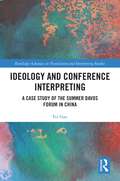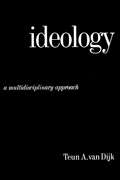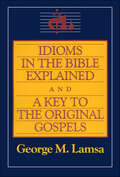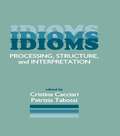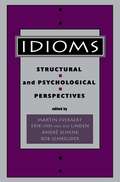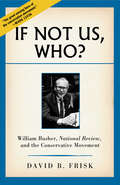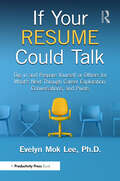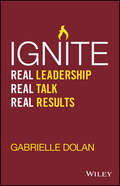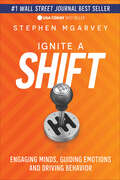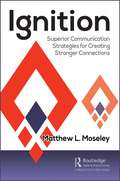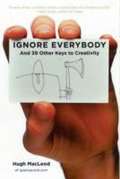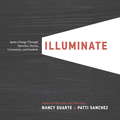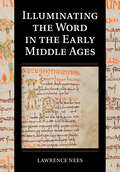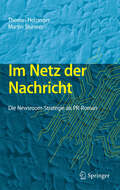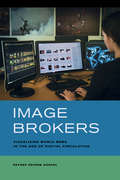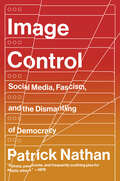- Table View
- List View
Ideology and Conference Interpreting: A Case Study of the Summer Davos Forum in China (Routledge Advances in Translation and Interpreting Studies)
by Fei GaoGao uses the case of conference interpreting at the Summer Davos Forum in China to systematically reveal the ways in which ideology and linguistic ‘re-engineering’ can lead to discourse reconstruction. Translation and interpreting can never be wholly neutral practices in ‘multi-voiced’ transnational communication. Gao employs an innovative methodological synthesis to examine in depth a range of elements surrounding interpreters’ ideological positioning. These include analysing the appraisal patterns of the source and target texts, identifying ‘us’-and-‘them’ discourse structures, investigating interpreters’ cognitions, and examining the crossmodal means by which interpreters render paralanguage. Collectively, they bridge the gap between socio-political and ideological concerns on the one hand, and practical questions of discourse reconstruction in cross-language/ cultural events on the other, offering a panoramic perspective. An invaluable read for scholars in translation and interpreting studies, particularly those with an interest in political discourse or the international relations context.
Ideology: A Multidisciplinary Approach (Communication Ser.)
by Teun A. Van DijkThe definition of ideology continues to occupy scholars across a wide range of disciplines. In this book, Teun A van Dijk sketches a challenging new multidisciplinary framework for theorizing ideology. He defines ideology as the basis of the social representations of a group, its functions in terms of social relations between groups, and its reproduction as enacted by discourse. Contemporary racist discourse is examined to illustrate these ideological relations between cognition, society and discourse.
Idioms in the Bible Explained and a Key to the Original Gospels
by George M. LamsaExplanations of nearly 1,000 ancient idioms, metaphors, and figures of speech in the Old and New Testaments, from a renowned Bible translator.George M. Lamsa, who was raised speaking Aramaic in a community that followed customs largely unchanged since the times of Christ, offers accurate translations of important idioms, metaphors, and figures of speech found in the Scripture—and provides clear explanations of their meaning in biblical context.Just as Shakespeare, Milton, and Browning wrote in the vernacular for English-speaking people, Moses, the prophets, and the apostles wrote for their own people in the plain language of their times, so that even the unlearned might understand God’s Word. Over the centuries, inaccurate translations and misunderstandings of customs and concepts have led to difficulties in bringing the biblical message to contemporary English-speaking readers.For example, when a man says to Jesus, “let me bury my father,” Lamsa points out that this expression means, “Let me first take care of my father until he dies.” Traditionally, scholars assumed that this man’s father was dead and that Jesus was not interested in his burial. Lamsa's scholarship offers a more accurate understanding of the intent and spirit of this passage.Idioms in the Bible Explained and a Key to the Original Gospels goes far in correcting such errors that have crept into Biblical scholarship. Obscure and difficult passages from both Old and New Testaments are listed and compared with the King James version (though it will be helpful when used with any English version). These make clear the original meaning of such ancient idioms and assure that our grasp of the biblical message is more sound and rewarding. To further uncover the original teachings of Scripture, Lamsa discusses at greater length such topics as “The Language of Jesus,” “Aramaic Phraseology,” “The Sayings of Jesus,” “Early Translations,” and more.
Idioms: Processing, Structure, and Interpretation
by Cristina Cacciari Patrizia Tabossi"The book draws on a lot of research, is friendly to the reader, and will be of good value to teachers." Paul Nation, Victoria University of Wellington, Australia This comprehensive, up-to-date, and accessible text on idiom use, learning, and teaching approaches the topic with a balance of sound theory and extensive research in cognitive linguistics, psycholinguistics, corpus linguistics, and sociolinguistics combined with informed teaching practices. Idioms is organized in three parts: Part I includes discussion of idiom definition, classification, usage patterns, and functions. Part II investigates the process involved in the comprehension of idioms and the factors that influence individuals’ understanding and use of idioms in both L1 and L2. Part III explores idiom acquisition and the teaching and learning of idioms, focusing especially on the strategies and techniques used to help students learn idioms. To assist the reader in grasping the key issues, study questions are provided at the end of each chapter. The text also includes a glossary of special terms and an annotated list of selective idiom reference books and student textbooks. Idioms is designed to serve either as a textbook for ESL/applied linguistics teacher education courses or as a reference book. No matter how the book is used, it will equip an ESL/applied linguistics students and professionals with a solid understanding of various issues related to idioms and the learning of them.
Idioms: Structural and Psychological Perspectives
by Martin Everaert André Erik-Jan van der Linden Rob SchreuderIdioms have always aroused the curiosity of linguists and there is a long tradition in the study of idioms, especially within the fields of lexicology and lexicography. Without denying the importance of this tradition, this volume presents an overview of recent idiom research outside the immediate domain of lexicology/lexicography. The chapters address the status of idioms in recent formal and experimental linguistic theorizing. Interdisciplinary in scope, the contributions are written by psycholinguists and theoretical and computational linguists who take mutual advantage of progress in all disciplines. Linguists supply the facts and analyses psycholinguists base their models and experiments on; psycholinguists in turn confront linguistic models with psycholinguistic findings. Computational linguists build natural language processing systems on the basis of models and frameworks provided by theoretical linguists and, sometimes psycholinguists, and set up large corpora to test linguistic hypotheses. Besides the fascination for idioms that make up such a large part of our knowledge of language, interdisciplinarity is one of the attractions of investigations in idiomatic language and language processing.
If I Understood You, Would I Have This Look on My Face?: My Adventures in the Art and Science of Relating and Communicating
by Alan Alda<P>Alan Alda, the award-winning actor and bestselling author, tells us the fascinating story of his quest to learn how to communicate better, and to teach others to do the same. With his trademark humor and candor, he explores how to develop empathy as the key factor. Alan Alda has been on a decades-long journey to discover new ways to help people communicate and relate to one another more effectively. <P>If I Understood You, Would I Have This Look on My Face? is the warm, witty, and informative chronicle of how Alda found inspiration in everything from cutting-edge science to classic acting methods. His search began when he was host of PBS’s Scientific American Frontiers, where he interviewed thousands of scientists and developed a knack for helping them communicate complex ideas in ways a wide audience could understand—and Alda wondered if those techniques held a clue to better communication for the rest of us. <P>In his wry and wise voice, Alda reflects on moments of miscommunication in his own life, when an absence of understanding resulted in problems both big and small. He guides us through his discoveries, showing how communication can be improved through learning to relate to the other person: listening with our eyes, looking for clues in another’s face, using the power of a compelling story, avoiding jargon, and reading another person so well that you become “in sync” with them, and know what they are thinking and feeling—especially when you’re talking about the hard stuff. <P>Drawing on improvisation training, theater, and storytelling techniques from a life of acting, and with insights from recent scientific studies, Alda describes ways we can build empathy, nurture our innate mind-reading abilities, and improve the way we relate and talk with others. Exploring empathy-boosting games and exercises, If I Understood You is a funny, thought-provoking guide that can be used by all of us, in every aspect of our lives—with our friends, lovers, and families, with our doctors, in business settings, and beyond. <P><b>A New York Times Bestseller</b>
If Not Us, Who?: William Rusher, National Review, and the Conservative Movement
by David B. FriskIf Not Us, Who? is both the story of an architect of the modern conservative movement and a colorful journey through a half century of high-level politics. Best known as the longtime publisher of National Review, William Rusher (1923–2011) was more than just a crucial figure in the history of the Right&’s leading magazine. He was a political intellectual, tactician, and strategist who helped shape the historic rise of conservatism. To write If Not Us, Who?, David B. Frisk pored over Rusher&’s voluminous papers at the Library of Congress and interviewed dozens of insiders, including National Review founder William F. Buckley Jr., in addition to Rusher himself. The result is a gripping biography that shines new light on Rusher&’s significance as an observer and an activiast while bringing to life more than a generation&’s worth of political hopes, fears, and controversies. Frisk vividly captures the joys and struggles at National Review, including Rusher&’s complex relationship with the legendary Buckley. Here we see the powerful blend of wit, erudition, dedication, shrewdness, and earnestness that made Rusher an influential figure at NR and an indispensable link between conservatism&’s leading theorists and its political practitioners. &“If not us, who? If not now, when?&”—a maxim often attributed to Ronald Reagan—could have been Rusher&’s motto. In everything he did—publishing National Review, recruiting and advising political candidates, organizing cadres of young conservatives, taking on liberal advocates in a popular television debate program, writing a syndicated column—his objective was to build a movement. His tireless efforts proved essential to conservatism&’s ascendancy, from the pivotal Goldwater campaign through the Reagan era. Largely unexamined until now, Rusher&’s career opens a new window onto the history of the conservative movement. This comprehensive biography reintroduces readers to a remarkable man of thought and action.
If Your Resume Could Talk: Dig in and Prepare Yourself or Others for What's Next Through Career Exploration, Conversations, and Pivots
by Evelyn Mok LeeThe notion that one can work in a single company or job for an extended period of time has changed. Companies are in need of talent. People are in search of jobs and just "the right position" for themselves.How do we find that perfect match? In years past, one might pivot once, perhaps even twice over the course of their career. Today, a person may need to pivot multiple times. Can a business adapt to the amount of change their employees may need to make over the course of their lifetime? Will an individual want to or be prepared to change jobs on an ongoing basis throughout their career? Sometimes, there is a need to pivot. Can the pivot be made, smoothly? Finding starting points for these conversations can be challenging. Is it a pivot or is it a career change? Both are acceptable. Pivots, if planned, can be easier to navigate. Career changes require more preparation. Either way, fluctuations can be daunting, for both the individual and the organizations they work for, especially when there is a lack of clarity in managing the complexities of skills, career aspirations, and interests. Having meaningful conversations that gather personal insights and reveal options either before or when it is time to initiate career exploration can ease the transition.This book captures the insights the author has gained through her career and provides the valuable lessons learned from reviewing resumes, interviewing, and coaching those early in their careers, starting new careers, or in the midst of career transitions. The author also shares her personal experience with career exploration and navigating change.
If You’d Just Let Me Finish
by Jeremy ClarksonClarkson is back with a brand new book of hilarious stories and observations about our gone-wrong world. ___________In November 2016 we woke up to the news that the forthright presenter of a popular television programme had become the most powerful man on the planet. His name, sadly, was not Jeremy Clarkson, but we might not have been any more surprised if it had been.Because the world seems to have taken a decidedly odd turn since Jeremy last reflected on the state of things between the covers of a book. But who better than JC to help us navigate our way through the mess?And while he's being trying to make sense of it all he's discovered one or two things along the way, including- The disabling effects of being vegan- How Blackpool might be improved by drilling a hole through it- The problem with meditation- A perfect location for rebuilding Palmyra- Why Tom Cruise can worship lizards if he wants toIt's all been a bit unsettling.But don't worry. If You'd Just Let Me Finish is Clarkson at his best. He may be as bemused, exasperated, amused and surprised as the rest of us, but in a world gone crazy, thank God someone has still got his head screwed on ...Praise for Clarkson:'Brilliant...laugh-out-loud' - Daily Telegraph'Outrageously funny...will have you in stiches' - Time Out'Very funny...I cracked up laughing on the tube' - Evening Standard
If the Spirit Moves You: Life and Love After Death
by Justine PicardieIf the Spirit Moves You is the story of life after death--it chronicles a year in the life of Justine Picardie following the death of her sister, her soul-mate, from breast cancer. It tells of the yearning to conjure again a voice from the vast silence, of how we fill the space that appears when someone dies, or how the void fills itself, of a bond between sisters that, like an endless conversation, carries on. Told in a series of diary entries from Good Friday 2000 to Easter Sunday 2001, it is filled with significant characters from the author's life--her Jewish academic father, who searches for answers to life's existential questions in the Kabbalah; her Catholic therapist mother; her husband; her children-as well as the spiritualists she encounters and their machines that speak to the dead. If the Spirit Moves You is poignant and bracing, cosmic and uplifting, all at once.
Ifigenia en Forest Hills: Anatomía de un asesinato
by Janet MalcolmUno de los mejores libros sobre un juicio jamás escritos. «Ella no lo pudo haber hecho, pero tenía que haberlo hecho». Ese es el enigma del que parte el fascinante nuevo libro de Janet Malcolm: la crónica de un juicio por asesinato en la cerrada comunidad de judíos bujaríes de Forest Hills, en el distrito neoyorquino de Queens. La joven y atractiva doctora Mazoltuv Borujova es acusada de haber contratado a un sicario para acabar con su ex marido, Daniel Malakov, un dentista respetado, en presencia de la hija de ambos, de cuatro años. El fiscal lo considera un acto de venganza: pocas semanas antes del asesinato a sangre fría de Malakov, este, inexplicablemente, había obtenido la custodia de la niña. La tragedia dickensiana del niño inocente es el hilo conductor del relato de Malcolm. Con la precisión intelectual y emocional que la caracteriza, Malcolm contempla el juicio («una pugna entre dos relatos antagónicos») desde todos los ángulos imaginables. El abismo entre nuestros ideales de justicia y los factores humanos que influyen en su aplicación (de la habilidad de los distintos abogados a la naturaleza de la selección de los jurados, la maleabilidad de las pruebas o la predisposición del juez) quizá sea la conclusión más dura. Reseñas:«Tan intrigante y emocionante como una historia de detectives, con todo el interés moral e intelectual de una gran novela.»Jeffrey Rosen «Seca y fascinante, Ifigenia en Forest Hills provoca desde sus primeras páginas un auténtico hechizo, el tipo de hechizo al que los admiradores de Janet Malcolm nos hemos hecho adictos.»The New York Times «Otro logro asombroso de Janet Malcolm. Aquí, como siempre, Malcolm provoca el mejor tipo de inquietud en el lector: la obligación de pensar.»Jeffrey Toobin
Ignite
by Gabrielle DolanLearn the authentic leadership skills that drive today's workforce to excel Ignite: Real Leadership, Real Talk, Real Results is an honest guide to achieving lasting business success by becoming a more authentic leader. Leaving behind the boring and mundane, this guide cuts to the chase with a frank and forthright style to provide insight that can radically transform your business. You'll learn how your communication style may be holding you back, and how a few simple changes can inspire your team, engage your customers, and remind you just how effective you can be. Storytelling is a powerful business tool, and this book shows how to find your own stories and dig deep to learn what's driving your leadership and motivating your diverse workforce. You'll successfully navigate the uncertain terrain brought about by mixed generational expectations, evolving technology, and a rapidly shifting culture as you learn to respond and adapt to become a more effective leader. Communication is everything, and leaders are expected to be "on message" at all times. Today's workers want to know the "why" behind the "what", and this guide shows you how to tailor your message and your entire communication style to have the biggest impact. Cut through the "boring" and "bull" and be real Communicate with impact across all platforms Ignite your teams, your customers, and yourself Level up, step out, and discover what you stand for The rapid rise of technology and social media has resulted in "information fatigue", and most leaders respond by communicating in logic and data. This approach has little impact on the shifting workforce demographics, and each new generation brings higher expectations from their employers and leaders. Ignite shows you how to exceed those expectations and become the authentic leader that drives today's business success.
Ignite a Shift: Engaging Minds, Guiding Emotions and Driving Behavior
by Stephen McGarveyHow effective leaders use communication to spark transformation: “Terrific insights and tools on how to create behavioral shifts.” —John Howlett, President, Bunzl CanadaThe ability to persuade and influence is the cornerstone of successfully navigating change management. In Ignite a Shift, internationally acclaimed speaker Stephen McGarvey explores the subtleties of effective communication and highlights the essential fact that thinking impacts emotions, which drive behavior.Ignite a Shift is the quintessential guide to communication, positive persuasion, and influencing with integrity. It reveals the proven techniques that the world’s most effective leaders are using to motivate themselves and others to excel professionally and personally.“An insightful guide that supplies readers with practical tools to help influence, persuade, and motivate the people around them. The focus on the power of positivity, linguistics, and storytelling are crucial techniques whether you are leading a team, negotiating a contract, or simply attempting to better frame conversations in everyday life.” —Michael Baghramian, Financial Advisor, Forbes List of America’s Next Gen Advisors, 2019 & 2021
Ignition: Superior Communication Strategies for Creating Stronger Connections
by Matthew L. MoseleyIgnition: Superior Communication Strategies for Creating Stronger Connections is a book of dispatches from the frontlines of communication strategy. Matthew L. Moseley draws on his eclectic life experiences to investigate the link between success and effective communication. Whether he’s choreographing a fine dining experience at the top restaurant in America, using rock stars to register voters, helping a national chain save its reputation after a gaffe goes viral, or serving as media liaison at the epic ash-blast send-off for author Hunter S. Thompson, Moseley identifies the principles that guide communication strategies toward their goals. In extensive interviews with a wide variety of experts, including authors, fighter pilots, business leaders, politicians, and astrophysicists, Moseley tests these principles, teases out new, provocative ideas, and anticipates how forming stronger connections will help us address today’s greatest challenges. Though it tackles serious subjects, offers an illuminating perspective on the evolution of human discourse, and shares important insights on interpersonal relations, Ignition is also a good, fun read. A broad range of colorful anecdotes gives this book of philosophical wisdom and practical advice the zest of a juicy memoir.
Ignore Everybody: And 39 Other Keys to Creativity
by Hugh MacleodIn this book, the author has expanded his thoughts about unleashing creativity in a world that often thwarts it.
Il Segreto del Carisma: Essere carismatico non è così difficile come sembra
by Danilo H. GomesDiventare una persona carismatica potrebbe sembrare un obiettivo impossibile per un introverso. Tuttavia, per quanto possa essere una caratteristica rara da incontrarsi oggi, è possibile raggiungere l’intento (ed è più facile di quanto si dica). Con le tecniche corrette, puoi diventare una persona con un carisma incredibile. Il SEGRETO DEL CARISMA raccoglie le più grandi caratteristiche di una persona carismatica con le relative istruzioni per metterle in pratica. Il libro propone tecniche efficaci, con un linguaggio accessibile e chiaro, dividendo il tema in argomenti ben organizzati. Diventa una persona carismatica perché tu sia maggiormente notato, o notata, a partire da oggi stesso.
Il podcasting semplice: come avviare e guadagnare dai podcast
by Adidas WilsonSostanzialmente un podcast è una specie di trasmissione radiofonica. L'unica differenza è che il podcast presenta determinati vantaggi, come ad esempio la possibilità di ascoltarli quando lo si desidera, invece che ad una certa ora o un determinato giorno. I podcast somigliano molto a dei talk show radiofonici, tuttavia sono molto diversi tra loro, come i video YouTube e la televisione. Un podcast può essere descritto perfettamente come una serie di episodi in formato di file audio, lo stesso che si utilizza per la musica su smartphone o laptop. Proprio come qualsiasi altro spettacolo televisivo o radiofonico, un podcast si incentra solitamente su un tema: ad esempio i videogiochi, l'horror, lo spettacolo, lo sport, la politica, ecc.. In ogni episodio si affronta un tema. Puoi scegliere di iscriverti ad un podcast (solitamente in forma gratuita) o ascoltare un episodio singolo. Un podcast piuttosto famoso è Pod Saves America, in cui si affrontano tematiche di cronaca politica. I conduttori sono Daniel Pfeiffer, Jon Lovett, Tommy Vietor e Jon Favreau. Spesso invitano esperti a esprimere la propria opinione. Gli episodi sono incentrati principalmente su tematiche politiche, come la riforma fiscale o la sanità pubblica. Un altro podcast è Critical Role.
Illuminate: Ignite Change Through Speeches, Stories, Ceremonies, and Symbols
by Nancy Duarte Patti Sanchez"THE PEOPLE WHO ARE CRAZY ENOUGH TO THINK THEY CAN CHANGE THE WORLD ARE THE ONES WHO DO." With these words, Apple Inc., and its leader, Steve Jobs, catalyzed a movement. Whenever Jobs took the stage to talk about new Apple products, the whole world seemed to stop and listen. That's because Jobs was offering a vision of the future. He wanted you to feel what the world might someday be like, and trust him to take you there.As a leader, you have the same potential to not only anticipate the future and invent creative initiatives, but to also inspire those around you to support and execute your vision.In Illuminate, acclaimed author Nancy Duarte and communications expert Patti Sanchez equip you with the same communication tools that great leaders like Jobs, Howard Schultz, and Dr. Martin Luther King Jr. used to move people. Duarte and Sanchez lay out a plan to help you lead people through the five stages of transformation using speeches, stories, ceremonies, and symbols.This visual and accessible communication guidebook will show you how Apple, Starbucks, IBM, charity: water, and others have mobilized people to embrace bold changes.To envision the future is one thing, getting others to go there with you is another. By harnessing the power of persuasive communication you, too, can turn your idea into a movement.From the Hardcover edition.
Illuminating the Word in the Early Middle Ages (Cambridge Studies in Palaeography and Codicology #18)
by Lawrence NeesThis richly illustrated study addresses the essential first steps in the development of the new phenomenon of the illuminated book, which innovatively introduced colourful large letters and ornamental frames as guides for the reader's access to the text. Tracing their surprising origins within late Roman reading practices, Lawrence Nees shows how these decorative features stand as ancestors to features of printed and electronic books we take for granted today, including font choice, word spacing, punctuation and sentence capitalisation. Two hundred photographs, nearly all in colour, illustrate and document the decisive change in design from ancient to medieval books. Featuring an extended discussion of the importance of race and ethnicity in twentieth-century historiography, this book argues that the first steps in the development of this new style of book were taken on the European continent within classical practices of reading and writing, and not as, usually presented, among the non-Roman 'barbarians'.
Illustrated Religious Texts in the North of Europe, 1500-1800
by Adam Morton Feike Dietz Lien RoggenIn recent years many historians have argued that the Reformation did not - as previously thought - hamper the development of Northern European visual culture, but rather gave new impetus to the production, diffusion and reception of visual materials in both Catholic and Protestant milieus. This book investigates the crosscurrents of exchange in the realm of illustrated religious literature within and beyond confessional and national borders, and against the background of recent insights into the importance of, on the one hand material, as well as on the other hand, sensual and emotional aspects of early modern culture. Each chapter in the volume helps illuminate early modern religious culture from the perspective of the production of illustrated religious texts - to see the book as object, a point at which various vectors of early modern society met. Case studies, together with theoretical contributions, shed light on the ways in which illustrated religious books functioned in evolving societies, by analysing the use, re-use and sharing of illustrated religious texts in England, France, the Low Countries, the German States, and Switzerland. Interpretations based on points of material interaction show us how the most basic binaries of the early modern world - Catholic and Protestant, word and image, public and private - were disrupted and negotiated in the realm of the illustrated religious book. Through this approach, the volume expands the historical appreciation of the place of imagery in post-Reformation Europe.
Im Netz der Nachricht
by Thomas Holzinger Martin SturmerDie beiden Kommunikationsprofis zeichnen in ihrem Roman ein Sittenbild der aktuellen Medienlandschaft und liefern zugleich ein Beispiel dafür, wie die "Newsroom-Strategie" in der Unternehmenskommunikation umgesetzt werden kann. Im Mittelpunkt steht dabei die Nachricht als ältester und schwierigster Teil der menschlichen Massenkommunikation: knapp, schnell und bedeutend. Die moderne Kommunikationsabteilung wird zum Newsroom, der multimedial und grenzenlos agiert und alle Zielgruppen auf allen Plattformen bedient - von der Lokalzeitung bis Twitter.
Im Netz der Nachricht: Die Newsroom-Strategie als PR-Roman
by Thomas Holzinger Martin SturmerDie beiden Kommunikationsprofis zeichnen in ihrem Roman ein Sittenbild der aktuellen Medienlandschaft und liefern zugleich ein Beispiel dafür, wie die „Newsroom-Strategie“ in der Unternehmenskommunikation umgesetzt werden kann. Im Mittelpunkt steht dabei die Nachricht als ältester und schwierigster Teil der menschlichen Massenkommunikation: knapp, schnell und bedeutend. Die moderne Kommunikationsabteilung wird zum Newsroom, der multimedial und grenzenlos agiert und alle Zielgruppen auf allen Plattformen bedient – von der Lokalzeitung bis Twitter.
Im Sinne der Medien – Textverständlichkeit im Nachrichtenauswahlkontext
by Claudia ThomsKann Verständlichkeit zum Erfolg der Presse- und Medienarbeit beitragen? Oder anders gefragt: Welche Rolle spielt Verständlichkeit bei der journalistischen Nachrichtenauswahl? Ausgehend vom Konzept der Mediatisierung argumentiert die Studie, dass die Beachtung grundlegender Verständlichkeitsregeln als ein strategisches Mittel zur Beeinflussung der medialen Aufmerksamkeit angesehen werden kann. Denn Verständlichkeit als journalistisches Qualitätskriterium ist Teil der Medienlogik. Wer diese Medienlogik bei der Gestaltung der eigenen Kommunikation berücksichtigt, schreibt im Sinne der Medien und entspricht journalistischen Vorstellungen darüber, was überhaupt berichterstattenswert ist und wie über entsprechende Ereignisse zu berichten ist. Grundlage zur empirischen Überprüfung dieser Annahme ist eine input-output-analytische Untersuchung von Pressemitteilungen DAX-notierter Unternehmen sowie der daraus resultierenden Berichterstattung in ausgewählten Medien. Mit einer Kombination manueller und automatisierter Formen der Inhaltsanalyse wird dabei die sprachliche Komplexität der Pressemitteilungen bestimmt und die Wirkung dieser Komplexität auf den journalistischen Umgang mit den Pressemitteilungen untersucht.
Image Brokers: Visualizing World News in the Age of Digital Circulation
by Zeynep Devrim GürselHow does a photograph become a news image? An ethnography of the labor behind international news images, Image Brokers ruptures the self-evidence of the journalistic photograph by revealing the many factors determining how news audiences are shown people, events, and the world. News images, Zeynep Gürsel argues, function as formative fictions - fictional insofar as these images are constructed and culturally mediated, and formative because their public presence and circulation have real consequences in the world. Set against the backdrop of the War on Terror and based on fieldwork conducted at photojournalism's centers of power, Image Brokers offers an intimate look at an industry in crisis. At the turn of the 21st century, image brokers--the people who manage the distribution and restriction of news images--found the core technologies of their craft, the status of images, and their own professional standing all changing rapidly with the digitalization of the infrastructures of representation. From corporate sales meetings to wire service desks, newsrooms to photography workshops and festivals, Image Brokers investigates how news images are produced and how worldviews are reproduced in the process.
Image Control: Art, Fascism, and the Right to Resist
by Patrick NathanSusan Sontag meets Hanif Abdurraqib in this fascinating exploration of the unexpected connections between how we consume images and the insidious nature of Fascism.Images come at us quickly, often without context. A photograph of Syrian children suffering in the wake of a chemical attack segues into a stranger&’s pristine Instagram selfie. Before we can react to either, a new meme induces a laugh and a share. While such constant give and take might seem innocent, even entertaining, this barrage of content numbs our ability to examine critically how the world, broken down into images, affects us. Images without context isolate us, turning everything we experience into mere transactions. It is exactly this alienation that leaves us vulnerable to fascism—a reactionary politics that is destroying not only our lives and our nations, but also the planet&’s very ability to sustain human civilization. Who gets to control the media we consume? Can we intervene, or at least mitigate the influence of constant content? Mixing personal anecdotes with historical and political criticism, Image Control explores art, social media, photography, and other visual mediums to understand how our culture and our actions are manipulated, all the while building toward the idea that if fascism emerges as aesthetics, then so too can anti-fascism. Learning how to ethically engage with the world around us is the first line of defense we have against the forces threatening to tear that world apart.
